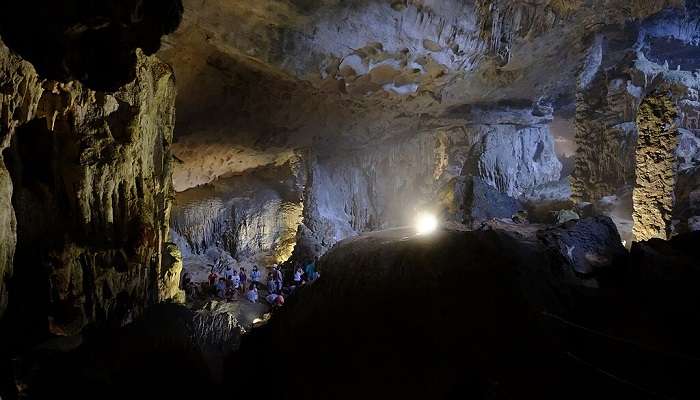Explore The Unique Caves Of Dau Go Cave At Halong Bay

Planning on an adventurous escapade with a dose of history? Visit Dau Go Cave at Halong Bay, Vietnam. Immerse in nature’s beauty and be impressed by the unique limestone formations standing majestically. Explore the cave network of Halong Bay for an out-of-world experience. Halong Bay, a UNESCO World Heritage Site with blue-green pristine waters and towering limestone cliffs, is a tapestry of rich history. Witness the captivating geological marvels and a maze of hidden caves waiting to be explored. Dau Go Cave, also known as Wooden Stakes Cave, holds a unique charm among these subterranean wonders.
Facts About The Dau Go Cave

Dau Go cave facts reveal a fascinating blend of history and natural beauty. Covering an area of approximately 5000 m2, Dau Go Cave enchants tourists with its peculiar cliff formations and teeming flora and fauna. Located 3 km from Tuan Chau Island and 6 km from the Bai Chay tourist spot, Dau Go cave features spellbinding views of nature’s creation.
The Cave formation dates back almost 2 million years and was discovered by French explorers in the 19th Century. The chambers of Dau Go are pretty airy and ventilated as sunlight enters the cave. These factors helped in the development of diverse flora like mosses, ferns, and tiny plants. Mesmerised by the beauty of these caves, the 12th Emperor of the Nguyen Dynasty penned a poem praising their charm, which was etched onto the left-hand side of the cave.
Must Read: Places To Visit In Vietnam With Family
Dau Go Cave History

Dau Go Cave’s history is associated with many legends. Specific stories passed down through the generations explain the cave’s unique title. According to the first legend and the local folklore, Dau Go Cave was also known as Giau Go Cave from old times as it is associated with ancient history dating back to the 13th century. Tran Hung Dao, the commander-in-chief of Vietnam, when the Tran soldiers planted wooden stakes in the Mongol war to destroy the enemy’s ships. The commander’s strategy led to a resounding victory and helped the country protect its borders from Mongol invaders. Post that, many wooden stakes were found left in the cave, and hence the name Dau Go Cave, misreading the word “Giau Go” or hiding wood.
According to the second legend, a series of bow-shaped Dau Go islands was in front of the cave. This island chain created a wind-tight area, helping the fishermen from storms while fishing. As people went to and from the islands, fishermen repaired their boats in these caves, which led to a few wooden stakes and boards. This gave rise to the name “Dau Go.” Finally, the third popular legend has a different explanation altogether. Since Dau Go Island, from a distance, resembles a large log with two holes at the extreme ends to thread ropes, people named it Dau Go Cave.
Dau Go Cave Tours

Vietnam is a stunning place with so much natural beauty, among them, Dau Go caves is one. Dau Go Cave Tours provide a memorable experience of natural beauty and history. Here are two ways you can get to the cave:
Option 1: Book a Halong cruise to visit the bay. Include Dau Go in the tour itinerary. This is the most convenient option for people travelling in large groups, with kids and elders.
Choose your tour carefully, and remember not all cruises go to Dau Go. Get a trip route beforehand to avoid disappointments and confusion during your Dau Go Cave Tours.
Option 2: Go to Tuan Chau Island ferry terminal, which is about 15-20 mins drive by car from the city centre. You can rent a boat at the ferry terminal to visit the cave.
Suggested Read: Vietnam Beach Resorts
Nearby Attractions To Explore
Exploring Halong Bay would be incomplete without a trip to the surrounding caves and islands. Indulge in kayaking and canoeing, visit the nearby caves, and relax on the serene beaches of the tiny islands.
1. Sung Sot Cave

Also called Surprise Cave, Sung Sot Caves are 8 km away from the Dau Go Cave. Discovered in 1907 by French explorers, these Surprise caves are in the centre of Ha Long Bay on Bo Hon Island. The entrance to the cave is narrow; take the stairs to get in.
Spanning an area of 10,000 sq. m and 30 m in height, Sung Sot Caves has two chambers Immerse in the beauty of these spectacular caves and amazing sceneries. The interiors are surprisingly colossal, hence the name.
Operating hours: 8.00 am – 6.00 pm
Entry ticket: USD 2.00
2. Ti Top Island

Explored enough limestone cliffs and seeking a break from the subterranean world? Ti Top Island is just the place to head to! Spanning over 3.7 hectares of area, this island offers a haven of relaxation with white sand, warm sun and splendid vistas.
This smallest island in Halong Bay is accessible by boat, yacht, or seaplane. This tiny paradise boasts a pristine beach with charming mountains and spectacular views. Indulge in water sports activities or just relax by the gorgeous beach. You can also choose to hike to the peak for panoramic views of the bay.
Operating hours: 8.00 am – 5.30 pm.
Entry ticket: Usually included with the tour to Halong Bay.
Suggested Read: Hanoi Street food
3. Thien Cung Cave

Thien Cung Cave is the most primitive and dry cave in Asia. Take a narrow winding path through the cliffs covered by dense foliage to access the cave to enter a colossal chamber. Legend has it that this cave was a wedding site of a Dragon King and a beautiful common girl, May.
You can still envision the grand wedding celebration in those stalactite formations and find the depictions of the dancing fairies at the wedding party. The second and third chambers also showcase the murals of different birds and fish enjoying the Dragon King’s wedlock. Admire and appreciate nature’s wonders at Thien Cung Cave.
Operating hours: 8.00 am – 5.30 pm.
Entry ticket: USD 2.00.
Further Read: Vietnam In August
Catch a captivating glimpse into the surreal world of Dau Go Cave. Explore these subterranean wonders beneath the surface of the waters, which stand as a testament to Vietnam’s rich history. Embrace the spirit of island exploration at Halong Bay. Hope this guide inspired you to journey to the land of wonders. So What are you waiting for? Plan a trip to Vietnam and Indulge in an experience that leaves you wanting more.
For our editorial codes of conduct and copyright disclaimer, please click here.
Cover Image Credit: Saaremees for Wikimedia Commons
Frequently Asked Questions About Dau Go Cave
What is the best time to visit Dau Go Cave?
The caves are generally open throughout the year, but the summer months, from April to August,, are the best time for exploration. June and July are the peak tourist seasons here.
Why is Dau Go Cave significant to the region?
The Mongol-Chinese invasions of Vietnam in the 13th century gave rise to the Dau Go caves' moniker, loosely translated as 'wooden heads.' The locals utilised the caves to store sharpened stakes they intended to use to destroy the Mongol ships.
What activities can be done around Dau Go Cave?
Snorkelling, canoeing, rock climbing, beach parachuting, and kayaking are a few of the interesting activities you can enjoy around Dau Go Cave.
How much time does it take to cover Dau Go Cave?
If you wish to cover the cave and its surroundings, it may take 2 to 3 hours. More time would be required to explore the nearby places. The entrance fee is roughly USD 2.5.
How many days are needed to visit Halong Bay?
You need at least 2 to 3 days to cover popular attractions in Halong Bay.
People Also Read:
Thailand Caves Kedarnath Cave Limestone Caves

With a passion for travelling, and carving beautiful stories of stunning locations I chose my profession as a content writer. The unique blend of creativity and strategy ensures that each narrative takes readers on a journey to their desired destination. With distinct locations and unique vibes, I strive to deliver captivating content that speaks to the hearts of readers.











